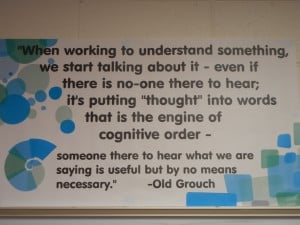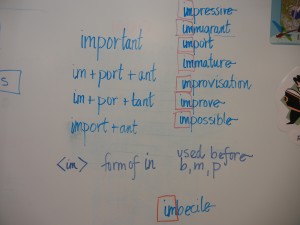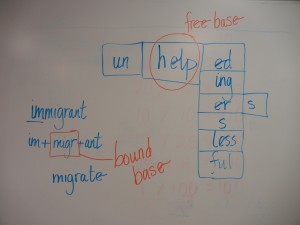Another fabulous week of orthographic discoveries! On my last orthography post I reported that most of the students were thinking that <photo> is the prefix in the word <photosynthesis>. Then our friend Old Grouch left a comment that gave us much to think about, and led to wonderful discoveries! The specific comment that he began with was, “I know that spellings which have the digraph ‘ph’ to represent /f/ are signalling a near certain Greek connection.” Right away the students named other words in which the digraph<ph> represented /f/: photosynthesis, phloem, cell phone, photograph, photographer, and elephant. So now we know that these and others like them may well have a Greek connection.
Another signal for a Greek connection that I was aware of was the digraph <ch> and how it sometimes represents /k/. The students began to name words like chorus, choir, synchronize (this was still on the board since we were discussing the prefix <syn> earlier), and chemical.
That’s when I threw out the thought, ” Isn’t it interesting that many of the words we’ve been using in our study of photosynthesis are tied to Greek?”
Bing! Light bulbs were going off in heads all over the room! Words were thrown out like photosynthesis, chloroplast, chlorophyll, and phloem.
From these rich discussions we went back to Old Grouch’s next comment, “Add to that the fact that the connecting vowel letter ‘-o-‘ is also a strong signal of Greek origin, and I was beginning to get the feeling that ‘photo’ is not only complex (that means it contains more than one element), but also that one of its elements could well actually be a base.” Hmmmm. What would that mean if the word had two bases?
As Allison, a student in my class last year once said, “It’s fun to discover new compound words. Everybody knows that starfish and rainbows are compound words. But not everybody knows that emancipation (or in this case photosynthesis) is a compound word.”
So Old Grouch, approaching this idea with a scientific mindset, searched for words that had the <phot> morpheme but were not followed by an <o>. He found one! He found the word <photic>! He even found the word used to describe a sneeze. He found that a photic sneeze is when someone sneezes because of a bright light. So here is the evidence that the <o> in <photo> is a connecting vowel and not part of the base which is <phote>. If you are wondering why there is an <e> on this base, please read the comment on this post. Old Grouch has enlightened us again. Such interesting things to ponder!
At this point we went back to our word sum and rewrote it to say, <phote>+<o>+<syn>+<thesis> –> <photosynthesis>. My final question? How does knowing what these morphemes mean help us have a better understanding of <photosynthesis>? After a brief moment of thinking, one of the students offered this, ” Well, the water and carbon dioxide are being put <thesis> together <syn>, and that can’t happen without light energy <photo>. How’s that for brilliant? Even if we had done nothing else today, because of these 45 minutes, our day was well spent!
So what did they head into the weekend with? The desire to discover the true meaning of <hypothesis> and how its base is related in meaning to <photosynthesis>.




